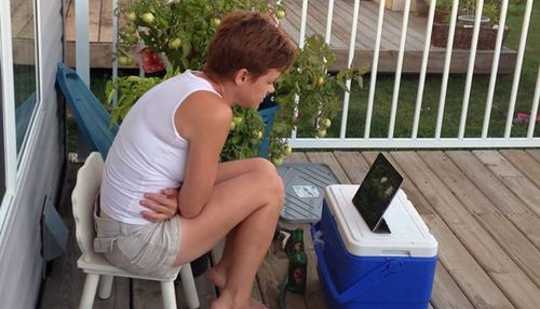
The Collins English Dictionary unveiled a thoroughly modern concept as its word of the year for 2015: binge watching. It usually refers to consuming endless hours of movies or series on Netflix, one after the other. But binge watching is about the more fundamental issue of the world’s obsession with content consumption.
A recent report on media use reveals that teens are now spending more hours consuming media than sleeping. The average American teenager is spending about nine hours a day on entertainment media alone. Is this really the huge problem it’s made out to be? Partly, yes - because while they are engaging with a lot of information during those nine hours, they are creating barely any content of their own in this time.
This passivity is being replicated in classrooms. What will it take to replace these with engaged, active classrooms?
Consuming - But Not Creating
All too often, parents see their children on devices and say: “You’re wasting your time.”
There may be times when this is true. But today’s devices are not like the single function radios and televisions their parents grew up with. In the past if a child was spending lots of time in front of the TV it was obvious they were doing only one thing - watching TV. Modern devices allow for a wide range of activities from consumption to conversation to creation. Even sitting in front of a TV a child today could be doing anything from having a conversation, playing a game, watching a movie or creating a world in Minecraft.
The problem arises when children aren’t doing any of these things during their nine hours of entertainment media. The research shows that on average, kids are spending about 40% of this time on “passive consumption” compared with just 3% of their time on content creation.
It would be easy to dismiss this if it only happened at home, in children’s own time. But there ought to be concern when this trend is picked up and implemented in classrooms. This is unfortunately exactly what’s happening.
New Tech, Old Methods
Schools are making a headlong rush to digitise the classroom. The media is awash with stories about tablets being rolled out, smartboards being installed or YouTubed classrooms. All of these technologies have great potential - yet at their core they are all about consumption. They do little to move the learner from a passive consumer to someone who is actively engaged.
The result is fuelling our students' “binge watching”, passive consumption diet. It is also leading to more and more studies suggesting that technology is not working in the classroom.
However, maybe it’s not the technology that isn’t working, but the way we’re using it. There is no doubt that our education system needs a revolution. That doesn’t mean doing what we have always done and just silicon coating it. A revolution needs new approaches to teaching and learning. It must be based on activity, not passivity.
Active Classrooms Are Possible
What is exciting is that the seeds for an activated classroom approach are already found in children’s current media habits. All that teachers and parents need to do is harness them. Another way to look at Common Sense Media’s research is in terms of the active things children are doing with media.
While they may be spending 40% of their time on passive consumption, they are spending 3% of their time creating content, 25% on “interactive consumption” and 26% communicating. That means they’re spending more than half their time actively engaging with media. It is these activities that hold promise for the future of classrooms.
Teachers must encourage a move away from passive content consumption towards active engagement with media in their classrooms. For example, rather than providing students with prepackaged course content, students can source and curate their own content using tools like Flipboard. Rather than passively watching videos, students can be actively involved in creating their own videos about the content.
{youtube}T3IU0danX6Q{/youtube}
Rather than simply reading content through books or ebooks, students can rather engage in conversations around the content, with tools like Google Hangouts.
{youtube}eabYzQqoMwA{/youtube}
Towards An Activated Classroom
While the binge watching trend may signal a worrying focus on consumption, research shows that active teaching and learning approaches are good for students. The future of our classrooms relies on teachers harnessing this energy, combining it with the benefits of technology - then activating learning in the classroom. By moving students from passive readers and hearers to active curators and creators, teachers can significantly impact both students' enthusiasm in the classroom and how much they learn.
About The Author
 Craig Blewett, Senior Lecturer in Education & Technology, University of KwaZulu-Natal. My focus is on the development of a usable digital pedagogy for teachers which can help advance how we teach and learn with technology.
Craig Blewett, Senior Lecturer in Education & Technology, University of KwaZulu-Natal. My focus is on the development of a usable digital pedagogy for teachers which can help advance how we teach and learn with technology.
This article was originally published on The Conversation. Read the original article.
Related Book:
at

Thanks for visiting InnerSelf.com, where there are 20,000+ life-altering articles promoting "New Attitudes and New Possibilities." All articles are translated into 30+ languages. Subscribe to InnerSelf Magazine, published weekly, and Marie T Russell's Daily Inspiration. InnerSelf Magazine has been published since 1985.

Thanks for visiting InnerSelf.com, where there are 20,000+ life-altering articles promoting "New Attitudes and New Possibilities." All articles are translated into 30+ languages. Subscribe to InnerSelf Magazine, published weekly, and Marie T Russell's Daily Inspiration. InnerSelf Magazine has been published since 1985.


























